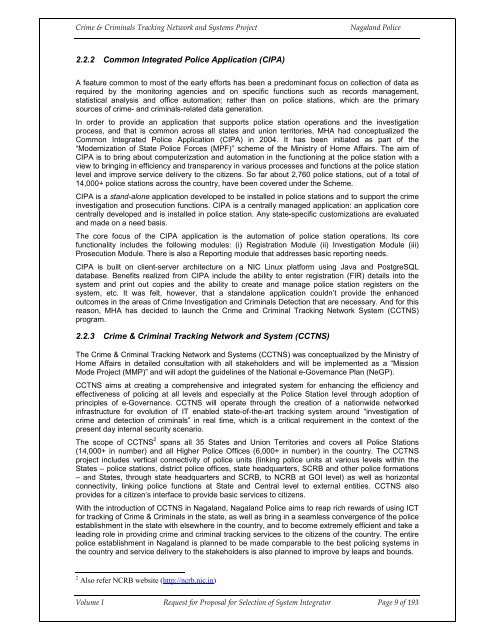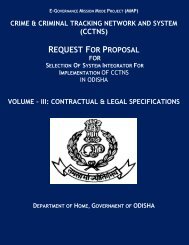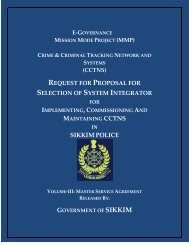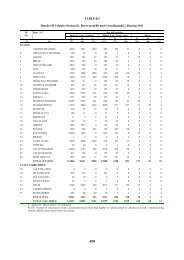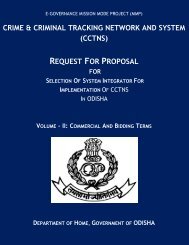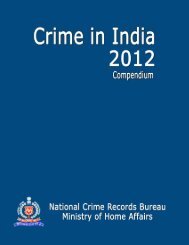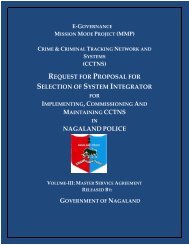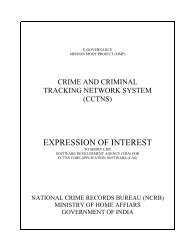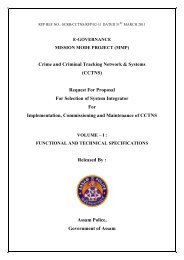CCTNS nagaland_SI_RFP_Volume 1.pdf - National Crime Records ...
CCTNS nagaland_SI_RFP_Volume 1.pdf - National Crime Records ...
CCTNS nagaland_SI_RFP_Volume 1.pdf - National Crime Records ...
- No tags were found...
Create successful ePaper yourself
Turn your PDF publications into a flip-book with our unique Google optimized e-Paper software.
<strong>Crime</strong> & Criminals Tracking Network and Systems ProjectNagaland Police2.2.2 Common Integrated Police Application (CIPA)A feature common to most of the early efforts has been a predominant focus on collection of data asrequired by the monitoring agencies and on specific functions such as records management,statistical analysis and office automation; rather than on police stations, which are the primarysources of crime- and criminals-related data generation.In order to provide an application that supports police station operations and the investigationprocess, and that is common across all states and union territories, MHA had conceptualized theCommon Integrated Police Application (CIPA) in 2004. It has been initiated as part of the“Modernization of State Police Forces (MPF)” scheme of the Ministry of Home Affairs. The aim ofCIPA is to bring about computerization and automation in the functioning at the police station with aview to bringing in efficiency and transparency in various processes and functions at the police stationlevel and improve service delivery to the citizens. So far about 2,760 police stations, out of a total of14,000+ police stations across the country, have been covered under the Scheme.CIPA is a stand-alone application developed to be installed in police stations and to support the crimeinvestigation and prosecution functions. CIPA is a centrally managed application: an application corecentrally developed and is installed in police station. Any state-specific customizations are evaluatedand made on a need basis.The core focus of the CIPA application is the automation of police station operations. Its corefunctionality includes the following modules: (i) Registration Module (ii) Investigation Module (iii)Prosecution Module. There is also a Reporting module that addresses basic reporting needs.CIPA is built on client-server architecture on a NIC Linux platform using Java and PostgreSQLdatabase. Benefits realized from CIPA include the ability to enter registration (FIR) details into thesystem and print out copies and the ability to create and manage police station registers on thesystem, etc. It was felt, however, that a standalone application couldn’t provide the enhancedoutcomes in the areas of <strong>Crime</strong> Investigation and Criminals Detection that are necessary. And for thisreason, MHA has decided to launch the <strong>Crime</strong> and Criminal Tracking Network System (<strong>CCTNS</strong>)program.2.2.3 <strong>Crime</strong> & Criminal Tracking Network and System (<strong>CCTNS</strong>)The <strong>Crime</strong> & Criminal Tracking Network and Systems (<strong>CCTNS</strong>) was conceptualized by the Ministry ofHome Affairs in detailed consultation with all stakeholders and will be implemented as a “MissionMode Project (MMP)” and will adopt the guidelines of the <strong>National</strong> e-Governance Plan (NeGP).<strong>CCTNS</strong> aims at creating a comprehensive and integrated system for enhancing the efficiency andeffectiveness of policing at all levels and especially at the Police Station level through adoption ofprinciples of e-Governance. <strong>CCTNS</strong> will operate through the creation of a nationwide networkedinfrastructure for evolution of IT enabled state-of-the-art tracking system around “investigation ofcrime and detection of criminals” in real time, which is a critical requirement in the context of thepresent day internal security scenario.The scope of <strong>CCTNS</strong> 2 spans all 35 States and Union Territories and covers all Police Stations(14,000+ in number) and all Higher Police Offices (6,000+ in number) in the country. The <strong>CCTNS</strong>project includes vertical connectivity of police units (linking police units at various levels within theStates – police stations, district police offices, state headquarters, SCRB and other police formations– and States, through state headquarters and SCRB, to NCRB at GOI level) as well as horizontalconnectivity, linking police functions at State and Central level to external entities. <strong>CCTNS</strong> alsoprovides for a citizen’s interface to provide basic services to citizens.With the introduction of <strong>CCTNS</strong> in Nagaland, Nagaland Police aims to reap rich rewards of using ICTfor tracking of <strong>Crime</strong> & Criminals in the state, as well as bring in a seamless convergence of the policeestablishment in the state with elsewhere in the country, and to become extremely efficient and take aleading role in providing crime and criminal tracking services to the citizens of the country. The entirepolice establishment in Nagaland is planned to be made comparable to the best policing systems inthe country and service delivery to the stakeholders is also planned to improve by leaps and bounds.2 Also refer NCRB website (http://ncrb.nic.in)<strong>Volume</strong> I Request for Proposal for Selection of System Integrator Page 9 of 193


